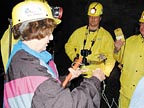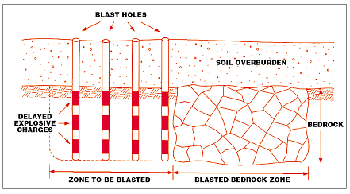

Blast fracturing is used principally to enhance the permeability of the geologic formations. The technology is applied by creating a blasted-bedrock zone or a blasted-bedrock trench of fractured rock that is positioned transverse to movement of a contaminant plume. Either linear or radial configurations are used depending on site requirements. Plume capture, control and treatment is accomplished by installing pumping wells within the trench. Following creation of the fractured zone, liquid supplements can be introduced to further enhance remediation. Emplacement of granular supplements such as iron powder into blast-fractured zones currently is under study.

For site remediation, all reported cases of blast fracturing have been applied to bedrock formations, especially hard rock such as crystalline granite and gneiss and competent sandstone and dolomite. Blast fracturing has most commonly been applied in the saturated zone, although vadose zone and perched zones also can be treated.
Report Abusive Comment